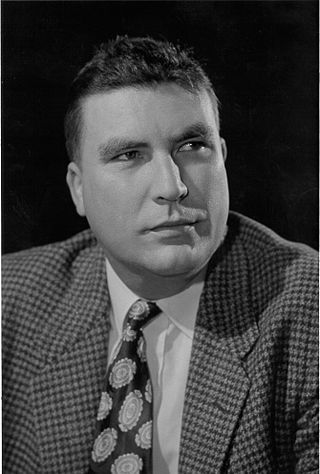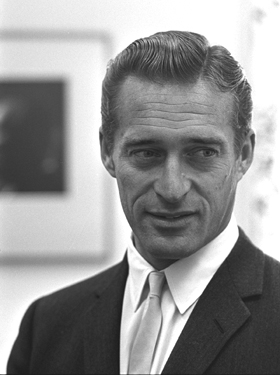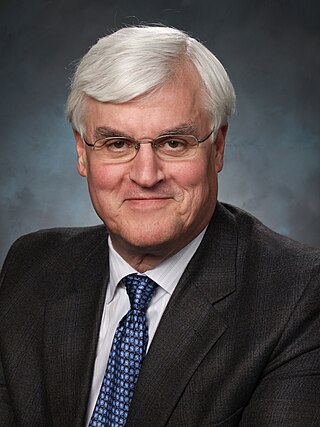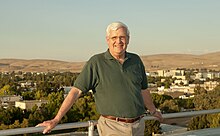Lawrence Livermore National Laboratory (LLNL) is a federally funded research and development center in Livermore, California, United States. Originally established in 1952, the laboratory now is sponsored by the United States Department of Energy and administrated by Lawrence Livermore National Security, LLC.

Herbert Frank York was an American nuclear physicist. He held numerous research and administrative positions at various United States government and educational institutes.

The National Ignition Facility (NIF) is a laser-based inertial confinement fusion (ICF) research device, located at Lawrence Livermore National Laboratory in Livermore, California, United States. NIF's mission is to achieve fusion ignition with high energy gain. It achieved the first instance of scientific breakeven controlled fusion in an experiment on December 5, 2022, with an energy gain factor of 1.5. It supports nuclear weapon maintenance and design by studying the behavior of matter under the conditions found within nuclear explosions.
David Herbert Munro is a physicist at Lawrence Livermore National Laboratory (LLNL) who created the programming language Yorick as well as the scientific graphics library Gist.

Sidney David Drell was an American theoretical physicist and arms control expert.

Michael Anastasio led two national science laboratories during a time of transition. He was the director of the Los Alamos National Laboratory and president of the Los Alamos National Security LLC, the company that operates the laboratory. He is the former director of Lawrence Livermore National Laboratory (LLNL). The University of California Board of Regents appointed Michael R. Anastasio the director of LLNL on June 4, 2002. He started on July 1, 2002. In 2005 he became the president of the Los Alamos National Security LLC, and became the director of the Los Alamos National Laboratory on June 1, 2006. During his directorship at Lawrence Livermore, the laboratory won 25 R&D 100 Awards and maintained its world-class leadership position in high-performance computing and its application to global climate modeling.

Curtis Bruce Tarter is an American theoretical physicist. He was the director of the Lawrence Livermore National Laboratory from 1994-2002. As director emeritus he recently published the first comprehensive history of the laboratory.
The Department of Applied Science at the University of California, Davis was a cooperative academic program involving the University of California, Davis and the Lawrence Livermore National Laboratory (LLNL). It was established in the fall of 1963 by Edward Teller, director of LLNL, and Roy Bainer, then dean of the UC Davis College of Engineering. The department was discontinued in 2011.

Edward Moses is an American physicist and is the former president of the Giant Magellan Telescope Organization. He is a past principal associate director for the National Ignition Facility & Photon Science Directorate, where he led the California-based NIF, the largest experimental science facility in the US and the world's most energetic laser, that hopes to demonstrate the first feasible example of usable nuclear fusion.
Richard Freeman Post was an American physicist notable for his work in nuclear fusion, plasma physics, magnetic mirrors, magnetic levitation, magnetic bearing design and direct energy conversion.
H. Pierre Noyes was an American theoretical physicist. He became a member of the faculty at the SLAC National Accelerator Laboratory at Stanford University in 1962. Noyes specialized in several areas of research, including the relativistic few-body problem in nuclear and particle physics.

John Stuart Foster Jr. is an American physicist, best known as the fourth director of Lawrence Livermore National Laboratory and as Director, Defense Research and Engineering under four Secretaries of Defense and two Presidents.

Penrose "Parney" C. Albright is an American physicist and nuclear weapon diagnostician known for his work with the U.S. Government, think tanks and National Laboratories, and government contractors. Since November 1, 2014, he has been the president and CEO of HRL Laboratories, a research firm jointly owned by Boeing and General Motors. Until December 2013 he served as the director of Lawrence Livermore National Laboratory, and, in 2014, he served as a senior advisor in the Office of the Director of National Intelligence.
William W. Simmons is an American physicist at TRW and Lawrence Livermore National Laboratory (LLNL), notable for his development of electro-optical devices.
Michael Dennis Feit (1942-2023) was an American physicist at the Lawrence Livermore National Laboratory, California.
Carol Travis Alonso is a Canadian-born American physicist, author and horsewoman. She was a co-discoverer of Element 106, Seaborgium, with Nobel laureate Glenn Seaborg and other team members at Lawrence Berkeley National Laboratory. She received her B.S. degree from Allegheny College, and her Ph.D. in nuclear physics from the Massachusetts Institute of Technology. Alonso worked on nuclear defense research and policy for 26 years at Lawrence Livermore National Laboratory (LLNL), where she managed various research programs and contributed to government policy on the role of nuclear testing.[1] She co-authored a Report to Congress on stockpile reliability. She collaborated with NASA astronaut Taylor Wang in experiments on Space Shuttle Challenger. Her research led to a nationally broadcast interview on NBC's Today Show. She was awarded a Gold Citation by Allegheny College for her work in national security. Alonso was appointed Assistant Associate Director for National Security until her retirement from LLNL in 2001. She now trains horses to dance to music. She won a bronze medal from the United States Dressage Federation. She competed a freestyle to music by invitation in the U.S. Dressage Finals in Lexington, KY. Alonso and her horse El Gavilan exhibited a Century Club ride for The Dressage Foundation. She has recently published an historical novel, Sun Stallion.
The Edward Teller Award is an award presented every two years by the American Nuclear Society for "pioneering research and leadership in the use of laser and ion-particle beams to produce unique high-temperature and high-density matter for scientific research and for controlled thermonuclear fusion". It was established in 1999 and is named after Edward Teller. The award carries a $2000 cash prize and an engraved silver medal.
Dmitri Dmitriyevich Ryutov is a Russian theoretical plasma physicist.
John D. Lindl is an American physicist who specializes in inertial confinement fusion (ICF). He is currently the chief scientist of the National Ignition Facility at the Lawrence Livermore National Laboratory.

Kimberly Susan Budil is an American physicist who is the 13th and current director of Lawrence Livermore National Laboratory, making her the first woman to hold this position. She completed her bachelor's degree in physics from the University of Illinois Chicago, and her master's and doctorate in applied science from the University of California, Davis. She collaborated with Nobel laureate Donna Strickland, and made significant contributions to the field of high-power, ultra-fast lasers. Starting her career at Lawrence Livermore National Laboratory in 1987, she held various roles across government departments, including the Department of Energy and the Department of Defense. In 2014, she managed relations between the University of California's campuses and the three Department of Energy labs it manages. Budil, who was made a fellow of the American Physical Society in 2019, has also been a prominent advocate for women in science.









